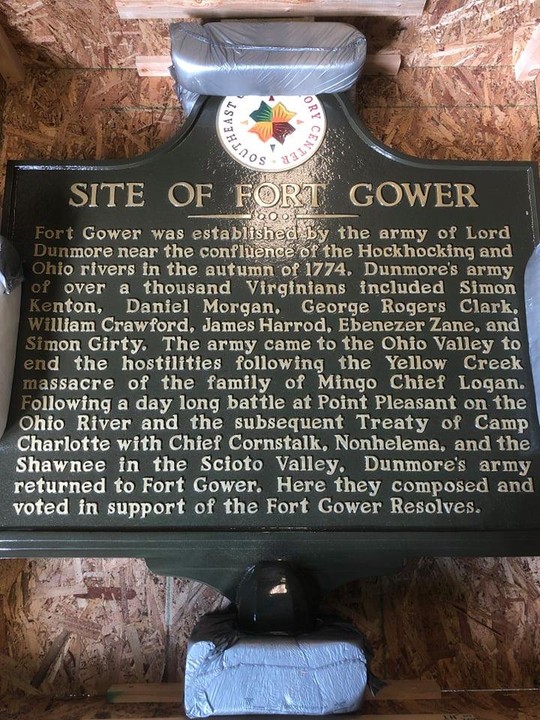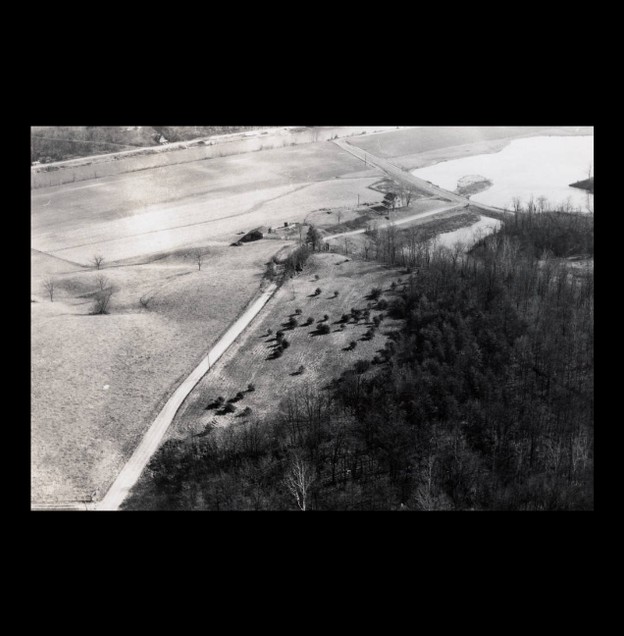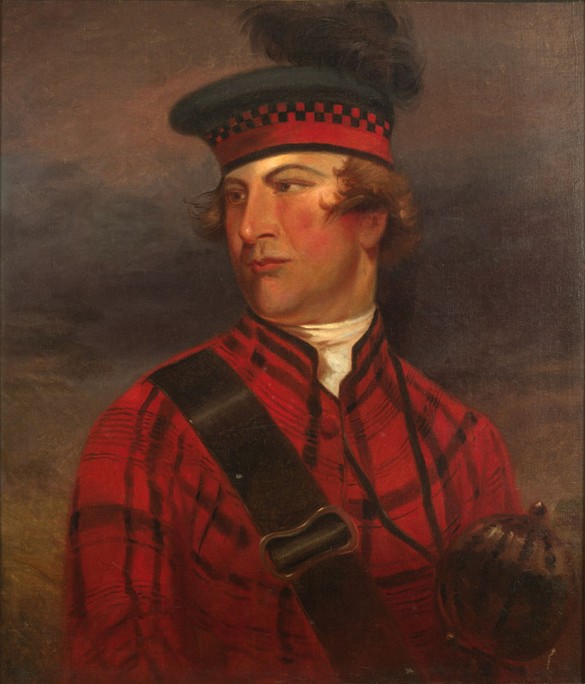Fort Gower Historical Marker
Introduction
Text-to-speech Audio
Images
The Fort Gower Historical Marker before installation, 2019

An aerial view of the site of Fort Gower, at the confluence of the Hocking and Ohio Rivers

John Murray, Lord Dunmore

Backstory and Context
Text-to-speech Audio
In 1774, conflict erupted along the Ohio River valley between Virginian settlers and regional Native American tribes, notably the Shawnee, Mingo, and Delaware, in a conflict known as Lord Dunmore's War (named after Virginia governor John Murray, Lord Dunmore). Hoping to seize the offensive, Lord Dunmore put together two colonial armies: a Northern Army commanded by himself and a Southern Army commanded by Colonel Andrew Lewis. Each force was comprised of roughly 1,400 Virginia militia. Col. Lewis' Southern army advanced westward along the Kanawha River Valley while Lord Dunmore's Northern Army forced moved down the Ohio River Valley from Wheeling.
The vanguard of Lord Dunmore's Northern Army was led by William Campbell. Campbell was familiar with the region, as he had accompanied Virginian and future President George Washington on a surveying mission in the region in 1770. When Campbell's force reached the confluence of the Hocking and Ohio Rivers in early October, a place where Campbell and Washington once encamped, they began building a small stockade called Fort Gower (named after an English earl). Lord Dunmore's full force arrived at Fort Gower less than a week later. Lord Dunmore hoped to call Andrew Lewis' Southern Army north to combine with Dunmore's own army in Indian territory west of the Ohio River.
Instead, Col. Lewis' army was attacked on October 10 by 700 Native Americans under Shawnee Chief Cornstalk at Point Pleasant. Virginian forces repulsed the attack, winning the decisive battle of Lord Dunmore's War. While Lewis fought at Point Pleasant, Dunmore's force advanced into Ohio and near modern Circleville, Ohio, he treated with local Native tribes. The resulting Treaty of Camp Charlotte ended the conflict, and the Ohio River was established as the boundary between white settlements and Native lands.
Victorious, Lord Dunmore led his Virginians back east towards their home colony. As they marched through Ohio, they were accompanied by Indian chiefs who sought to ensure the Virginians adhered to the treaty terms. When the Virginians reached Fort Gower, they paused for a time while the Indians returned west. Lord Dunmore departed. But disconcerting news soon arrived from the east.
Having been on the frontier campaigning for over two months, the Virginians knew nothing of the developing political crisis between Great Britain and her American colonies. In response to the British Coercive Acts and Quebec Acts (themselves a British reaction to the Boston Tea Party), the First Continental Congress met in Philadelphia and declared a boycott of British goods. Learning of Congress' actions, the militia officers at Fort Gower met on November 5, 1774 to discuss matters. The result was the Fort Gower Resolves (also known as the Fort Gower Resolutions):
"Resolved, that we will bear the most faithful allegiance to His Majesty, King George the Third, whilst His Majesty delights to reign over a brave and free people; that we will, at the expense of life, and everything dear and valuable, exert ourselves in support of his crown, and the dignity of the British Empire. But as the love of liberty, and attachment to the real interests and just rights of America outweigh every other consideration, we resolve that we will exert every power within us for the defense of American liberty, and for the support of her just rights and privileges; not on any precipitate, riotous or tumultuous voice of our countrymen. Signed by order and in behalf of the whole corps. Benjamin Ashby, Clerk."
The 1774 Fort Gower Resolves constituted the first declaration by American colonists that they were willing to utilize force against Britain if they felt their liberties were infringed. The Resolves were published on December 22, 1774 in the popular Virginia Gazette and were widely read. In March 1775, the Resolves were read before the House of Parliament in London to great outrage. One month later, American colonists in Massachusetts clashed with British regulars for the first time at Lexington and Concord, Massachusetts; the first shots of the American Revolution. Lord Dunmore proved a firm supporter of the Crown and was driven from Virginia by local Patriot forces.
Although Fort Gower itself ceased being used following Lord Dunmore's campaign, for decades following the war the outlines of the fort could be seen and relics were uncovered. The Daughters of the American Revolution placed a tablet at the site in 1923. In November 2019, the Southeast Ohio History Center placed a historic marker at the site acknowledging both Fort Gower and the Fort Gower Resolves.
Cite This Entry
Cowsert, Zachery. "Fort Gower Historical Marker." Clio: Your Guide to History. September 15, 2020. Accessed April 1, 2025. https://theclio.com/tour/1571/7
Sources
1. "Fort Gower Resolutions." Ohio History Central. Web. Accessed September 14, 2020. https://ohiohistorycentral.org/w/Fort_Gower_Resolutions
2. John F. Winkler. Point Pleasant 1774: Prelude to the American Revolution. New York: Osprey Publishing, 2014.
3. Marjorie Stone. "Local historian gives fuller picture of Fort Gower Resolves." November 15, 2019. Athens Messenger. Web. Accessed September 14, 2020. https://www.athensmessenger.com/blogs/guest_columnists/local-historian-gives-fuller-picture-of-fort-gower-resolves/article_2a8fcc16-1bf4-54c4-9c78-5e67c50bf39c.html
4. "Fort Gower Historic Marker Dedication--November 10, 2019." Southeast Ohio History Center. Web. Accessed September 14, 2020. https://athenshistory.org/fort-gower-historic-marker-dedication-november-10-2019/
5. S.B. Hildreth. Ohio Valley, and the Early Settlement of the Northwest Territory. Cincinnati, OH: H.W. Derby & Co., 1848.
6. "Fort Gower site photograph." Ohio History Connection. Web. Accessed September 14, 2020. https://ohiomemory.org/digital/collection/p267401coll32/id/14835
7. "Unveiling of Tablet at Fort Gower." Ohio History Journal. Web. Accessed September 14, 2020. https://resources.ohiohistory.org/ohj/browse/displaypages.php?display[]=0033&display[]=87&display[]=94
Southeast Ohio History Center, https://athenshistory.org/fort-gower-historic-marker-dedication-november-10-2019/
Ohio History Connection, https://ohiomemory.org/digital/collection/p267401coll32/id/14835/
Library of Virginia, https://edu.lva.virginia.gov/online_classroom/shaping_the_constitution/people/john_murray

